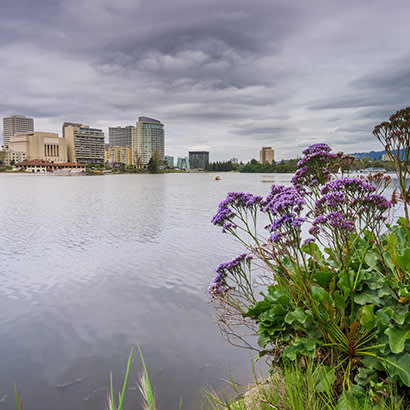
For an enhanced digital experience, read this story in the ezine.
As a kid, former East Bay Regional Park District Director Judge John Sutter flew model airplanes along the Oakland, California, shoreline. His childhood experiences led this dedicated Oaklander into a lifetime of staunch advocacy aimed at expanding public access to the shoreline. Nearly everywhere he went, he would declare: “There should be a park here!”
With time, Sutter’s beloved shoreline became less and less accessible as development dominated the landscape. What began as a patchwork of docks, quays, wharves and beltline railways boomed into an international airport and other industrial sites. With the development of Interstate 880 in 1972, the City of Oakland and its residents became largely separated from their shoreline. By the early 2000s, there was only one location in Oakland where passengers on Bay Area Rapid Transit trains and those on the freeway could see the water and be reminded of natural shorelines close to home. This location along the Oakland-Alameda Estuary became a priority for the determined, now grown, Sutter.
In all his advocacy work, Sutter, who passed away in May 2021, sought to improve access to parks, trails and open spaces for all. Equity was a critical pillar in his work. As a Superior Court Judge in Alameda County, California, for 14 years and at-large City Council member for 11 years, he believed firmly in fairness and inclusion. This drive for equitable access led Sutter to ensure the Oakland shoreline was preserved and forever accessible to the public. Sutter’s goals were complemented by the work of others. To increase public shoreline access, such as the Oakland-
Alameda Estuary location that inspired Sutter, the California Legislature adopted an aspirational law to create a 500-mile trail network around San Francisco Bay, known locally as the Bay Trail. Of this national model, some 350 miles are complete today and used regularly by commuters and recreationists alike. The remaining gaps, however, are the most challenging and expensive.
While active on the East Bay Regional Park District Board, Sutter convinced his colleagues to enter into a long-term lease agreement with the Port of Oakland to protect shoreline property for public access and Bay Trail connections. He even put his own money into the equation by donating $2 million to the Regional Parks Foundation (a nonprofit foundation that supports the park district) aimed at assisting in the acquisition of a critical piece of public shoreline property to close a Bay Trail gap. His generosity was inspiring. Once fully funded, the Oakland-Alameda Estuary location will include a 0.1-mile paved multi-use trail connection and park amenities to allow visitors to enjoy the water’s view. This new connection will allow trail users to relish their shoreline and offset carbon emissions through active transportation commuting to business and retail and enjoy healthful recreation close to home. The project also will reconnect the surrounding economically-challenged community with its shoreline. In Sutter’s legacy, the park district continues to pursue regional, state and federal grants to make his vision a reality — including as part of its Department of Transportation Rebuilding American Infrastructure with Sustainability and Equity (RAISE) grant application.
The park district was honored to have such a humble, determined, intelligent person with equitable and fair judgement on its board for 20 years. We honor his legacy of equity by working to ensure the last place in Oakland to still see the Estuary and San Francisco Bay is accessible for future generations of children and adults of all backgrounds to feel welcome and safe to fly model airplanes along the Oakland Shoreline for years to come.
Erich Pfuehler is Chief of Government and Legislative Affairs for East Bay Regional Park District. Lisa Baldinger is Legislative and Policy Management Analyst for East Bay Regional Park District.

